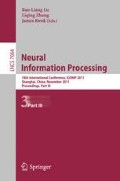Abstract
In this paper, under the efficient coding theory we propose a computational model to explore the intrinsic dimensionality of scene perception. This model is hierarchically constructed according to the information pathway of visual cortex: By pooling together the activity of local low-level feature detectors across a large regions of the visual fields, we build the population feature representation as the statistical summary of the input image. Then, a large amount of population feature representations of scene images are embedded unsupervisedly into a low-dimensional space called perceptual manifold. Further analysis on the perceptual manifold reveals the topographic properties that 1) scene images which share similar perceptual similarity stay nearby in the manifold space, and 2) dimensions of the space could describe the perceptual continuous changes in the spatial layout of scenes, representing the degree of naturalness, openness, etc. Moreover, scene classification task is implemented to validate the topographic properties of the perceptual manifold space.
Access this chapter
Tax calculation will be finalised at checkout
Purchases are for personal use only
Preview
Unable to display preview. Download preview PDF.
References
Nassi, J.J., Callaway, E.M.: Parallel processing strategies of the primate visual system. Nat. Rev. Neurosci. 10(5), 360–372 (2009)
Weliky, M., Fiser, J., Hunt, R.H., Wagner, D.N.: Coding of natural scenes in primary visual cortex. Neuron (2003)
Olshausen, B.A., Field, D.J.: Sparse coding of sensory inputs. Current Opinion in Neurobiology 14(4), 481–487 (2004)
Simoncelli, E.P., Olshausen, B.: Natural image statistics and neural representation. Annual Review of Neuroscience (2001)
Srivastava, A., Lee, A.B., Simoncelli, E.P., Zhu, S.-c.: On advances in statistical modeling of natural images. Journal of Mathematical Imaging and Vision (2003)
Seung, S.H., Lee, D.D.: Cognition: The manifold ways of perception. Science (2000)
Bell, A.J., Sejnowski, T.J.: The ”independent components” of natural scenes are edge filters. Vision Res. (1997)
van Hateren, J., van der Schaaf, A.: Independent component filters of natural images compared with simple cells in primary visual cortex. Proc. Royal Soc. Lond. B 265, 359–366 (1998)
Karklin, Y., Lewicki, M.S.: Emergence of complex cell properties by learning to generalize in natural scenes. Nature 457, 83–86 (2009)
Karklin, Y., Lewicki, M.S.: A hierarchical bayesian model for learning nonlinear statistical regularities in nonstationary natural signals. Neural Comp. 17(2), 397–423 (2005)
Roweis, S.T., Saul, L.K.: Nonlinear dimensionality reduction by locally linear embedding. Science (2000)
Serre, T., Wolf, L., Bileschi, S., Riesenhuber, M., Poggio, T.: Robust object recognition with cortex-like mechanisms. IEEE Trans. Pattern Anal. Mach. Intell. 29(3), 411–426 (2007)
Olshausen, B.A., Field, D.J.: Emergence of simple-cell receptive field properties by learning a sparse code for natural images. Nature 381(6583), 607–609 (1996)
Li, F.F., Perona, P.:
Oliva, A., Torralba, A.: Modeling the shape of the scene: A holistic representation of the spatial envelope. International Journal of Computer Vision (2001)
Oliva, A.: Gist of the scene. In: Itti, L., Rees, G., Tsotsos, J.K. (eds.) The Encyclopedia of Neurobiology of Attention, pp. 251–256. Elsevier, San Diego (2005)
Saul, L.K., Weinberger, K.Q., Ham, J.H., Sha, F., Lee, D.D.: Spectral methods for dimensionality reduction. Semisupervised Learning. MIT Press, Cambridge (2006)
Author information
Authors and Affiliations
Editor information
Editors and Affiliations
Rights and permissions
Copyright information
© 2011 Springer-Verlag Berlin Heidelberg
About this paper
Cite this paper
Zhu, M., Zhou, B. (2011). Modeling Manifold Ways of Scene Perception. In: Lu, BL., Zhang, L., Kwok, J. (eds) Neural Information Processing. ICONIP 2011. Lecture Notes in Computer Science, vol 7064. Springer, Berlin, Heidelberg. https://doi.org/10.1007/978-3-642-24965-5_78
Download citation
DOI: https://doi.org/10.1007/978-3-642-24965-5_78
Publisher Name: Springer, Berlin, Heidelberg
Print ISBN: 978-3-642-24964-8
Online ISBN: 978-3-642-24965-5
eBook Packages: Computer ScienceComputer Science (R0)

